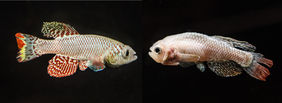MicroRNA as anti-aging molecule in brain
Jena. The older we get, our brain ages. Cognitive abilities decline and the risk of developing neurodegenerative diseases like dementia, Alzheimer’s and Parkinson’s disease or having a stroke steadily increases. A possible cause is the accumulation of iron molecules within neurons, which seems to be valid for all vertebrates. In a collaborative research project within the consortium JenAge, researchers from the Leibniz Institute on Aging – Fritz Lipmann Institute (FLI) in Jena, Germany, and the Scuola Normale Superiore (SNS) in Pisa, Italy, found that this iron accumulation is linked to a microRNA called miR-29. This little molecule has so far been known to act as a tumor suppressor, hindering the proliferation of cancer cells. However, clearly, miR-29 also regulates whether or not iron can be deposited in neurons. Using the African fish Nothobranchius furzeri – the shortest-living vertebrate that can be kept under laboratory conditions – the team of Alessandro Cellerino showed a large increase of iron deposits in fish where miR-29 had been suppressed, which led to premature brain aging. In contrast, healthy fish showed the more miR-29 in their neurons, the older they were. Hence, miR-29 acts as a kind of anti-aging molecule during aging, inhibiting the accumulation of iron in neurons.
New therapeutic approach for the treatment of neurodegenerative diseases and strokes
„We strongly believe that our results are relevant for humans as well“, says Alessandro Cellerino, Professor of Physiology at SNS in Pisa and guest scientist at the FLI, who is one of the study’s leaders. In fact, the link between an increased iron accumulation and neurodegenerative diseases or strokes in humans has been known for some time; there are also results showing a reduced concentration of miR-29 in these diseases. However, it is totally new that miR-29 acts as molecular switch that inhibits iron accumulation. “These results are surprising – and very promising, because the development of miR-29-based pharmaceuticals for cancer therapy is already ongoing. This may offer a head start for the development of new therapies for Parkinson’s or Alzheimer’s disease and for the treatment of strokes as well”, Cellerino adds.
First biomedical discovery in the young aging model “N. furzeri“
African killifish Nothobranchius furzeri has only recently been introduced as animal model in aging research. It was the deciphering of the fish’s genome in late 2015 by the Leibniz Institute on Aging (FLI) that laid the foundation for genetic studies in this fast-aging vertebrate. “The investment of ten years, which it took us and our collaborators to decipher the genome, now starts to pay off”, explains Prof. K. Lenhard Rudolph, who is the FLI’s Scientific Director. And Mario Baumgart, a Postdoc at the FLI that was involved in the study, adds: “There’s no other vertebrate showing such a rapid aging as this little fish. It is like aging in fast motion. Moreover, 90% of human genes can be found in the fish as well, making almost all knowledge gained from N. furzeri transferable to humans.” This is why the results about the molecular switch miR-29, which were published on February 13, 2017 in the journal BMC Biology are so promising and mean a further step towards the treatment of neurodegenerative diseases.
Publication
Ripa R, Dolfi L, Terrigno M, Pandolfini L, Savino A, Arcucci V, Groth M, Terzibasi Tozzini E, Baumgart M, Cellerino A. MicroRNA miR-29 controls a compensatory response to limit neuronal iron accumulation during adult life and aging. BMC Biology 2017, 15:9, DOI: 10.1186/s12915-017-0354-x.
Contact
Dr. Evelyn Kästner
Leibniz Institute on Aging – Fritz Lipmann Institute (FLI) | Beutenbergstr. 11 | 07745 Jena, Germany
p. +49 3641-656373, e. presse@~@leibniz-fli.de
Andrea Pantani
Scuola Normale Superiore Pisa | Piazza dei Cavalieri, 7 | 56126, Pisa, Italy
p. +39 050 509324, e. andrea.pantani@~@sns.it









